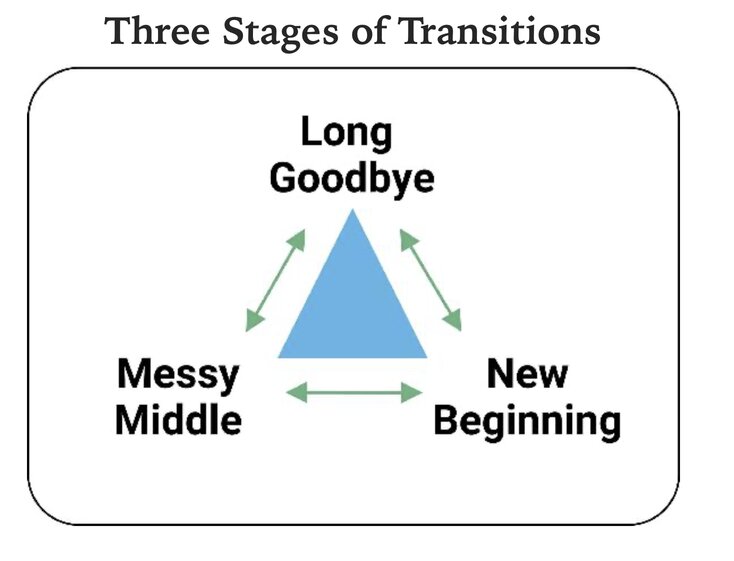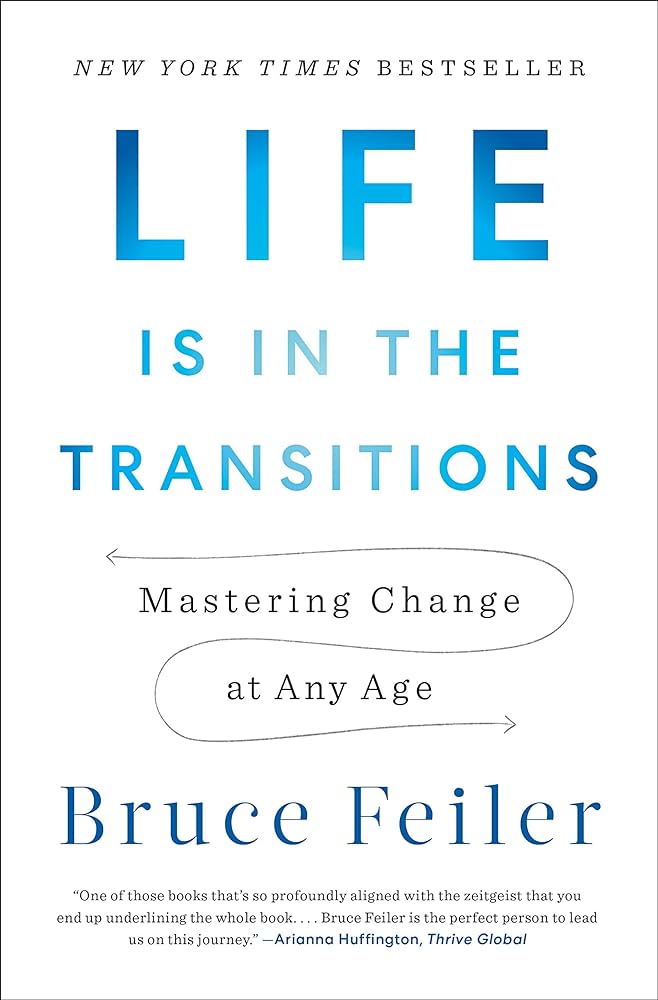Life is in the transitions as much as in the terms connected. – WILLIAM JAMES
In Life Is in the Transitions: Mastering Change at Any Age, New York Times bestsellers author Bruce Feiler writes about the nonlinear life, in which each of us faces dozens of disruptors. One in ten of those disruptors is what Feiler refers to as a lifequake, a massive change that leads to a life transition. The average length of these transitions is five years. The upshot: We all spend half our lives in this unsettled state. You or someone you know is going through one now.
The Life Story Project
Bruce crisscrossed the country, finding people with interesting life stories to tell; interviewed those people for hours about the transitions, disruptions, and reinventions of their lives; and then mined those stories for patterns and clues.
Life is the story you tell yourself
But how you tell that story—are you a hero, victim, lover, warrior, caretaker, believer—matters a great deal. How you adapt that story—how you revise, rethink, and rewrite your personal narrative as things change, lurch, or go wrong in your life—matters even more. What happens when we misplace the plot of our lives? When we get sidetracked by one of the mishaps, foul-ups, or reversals of fortune that appear with uncomfortable frequency these days? What happens when our fairy tales go awry? We get stuck in the woods and can’t get out.
“When in turmoil, turn to narrative. The proper response to a setback is a story.”
Shapes of Family Narrative
Our personal narratives, have shapes as much as our family ones do. Each of us carries around an unspoken set of assumptions that dictate how we expect our lives will unfold. These expectations come from all corners and influence us more than we admit. We’ve been led to believe that our lives will always ascend, for example, and are shocked to discover they oscillate instead. Our society tells us we should be basking in progress, but our experience tells us we are beset by slip-ups.
The Non-Linearity of Life
The smartest minds today—including those studying computers, biology, math, physics—have come to understand that the world no longer adheres to predictable, linear mandates. Instead, life is filled with chaos and complexity, periods of order and disorder, linearity and nonlinearity. In place of steady lines, observers now see loops, spirals, wobbles, fractals, twists, tangles, and turnabouts.
Continuous Re-Births
The idea that life follows a series of carefully calibrated progressions—childhood to young adulthood to middle age to old age; dating to marriage to children to empty nest; low-level job to mid-level job to senior-level job to retirement—seems preposterously outdated. Instead of passing through a series of preordained life stages interrupted by periodic crises on birthdays that end in zero, we experience life as a complex swirl of celebrations, setbacks, triumphs, and rebirths across the full span of our years.
The once routine expectation that people will have one job, one relationship, one faith, one home, one body, one sexuality, one identity from adolescence to assisted living is deader than it’s ever been. This is what it means to live a nonlinear life, and it has profound consequences for decisions we all make every day.
The Conflict
Conflict is the one precondition of a story. For there to be a narrative at all, something unforeseen must happen. The plot twists in Hollywood lingo; the peripeteia in Aristotle’s naming. “Everybody agrees that a story begins with some breach in the expected state of things,” writes Jerome Bruner, the pioneer of narrative psychology. “Something goes awry, otherwise there’s nothing to tell about.” The story is the tool to resolve this breach.
The number of disruptors a person can expect to experience in an adult life is around three dozen. That’s an average of one every twelve to eighteen months.
Lifequakes
Every now and then, one—or more commonly a pileup of two, three, or four—of these disruptors rises to the level of truly disorienting and destabilizing us.
A lifequake: a forceful burst of change that leads to a period of upheaval, transition, and renewal
The damage they cause can be devastating, they’re higher on the Richter scale of consequence, and their aftershocks can last for years. The average person goes through three to five of these massive reorientations in their adult lives; their average duration is five years. When you do the math, that means nearly half our lives are spent responding to one of these episodes.
You or someone you love is almost surely going through one now. Lifequakes may be voluntary or involuntary, but navigating the transitions that flow from them can only be voluntary. We must choose to deploy the skills.
The Non-Linear Life
A hallmark of our time is that life is not predictable. It does not unfold in passages, stages, phases, or cycles. It is nonlinear—and getting more so every day. It’s also more manageable, more forgiving of missteps, and more open to personalization, if you know how to navigate the new outbreak of twists and turns.
Nonlinearity suggests that instead of resisting upheavals and uncertainties like these, we should accept them. Yours is not the only life that seems to be following its own inscrutable path. Everyone else’s is, too.
Deck of Disruptors
Feller combed 225 life stories to generate a master list of the events that meaningfully redirected people’s lives. These events ranged from getting married to caring for an aging parent, from being fired to being sexually harassed, from overnight fame to public humiliation. The total number of disruptors was fifty-two. The parallel to a deck of cards is irresistible.
The ABC of Meaning
In the end, we identified three key ingredients of a well-balanced life.
- The A is agency—autonomy, freedom, creativity, mastery; the belief that you can impact the world around you.
- The B is belonging—relationships, community, friends, family; the people that surround and nurture you.
- The C is cause—a calling, a mission, a direction, a purpose; a transcendent commitment beyond yourself that makes your life worthwhile.
The three strands of our narrative identity.
Our me story
The first is our me story—the one in which we’re the hero, the doer, the creator; we exercise agency and, in return, feel fulfilled.
Our we story
The next is our we story—the one in which we’re part of a community, a family, a team; we belong to a group and, in turn, feel needed.
our thee story
The third is our thee story—the one in which we’re serving an ideal, a faith, a cause; we give of ourselves to others and, by extension, feel part of something larger.
A is for Agency
The psychologist Bessel van der Kolk defines agency as “the feeling of being in charge of your life: knowing where you stand, knowing that you have a say in what happens to you, knowing that you have some ability to shape your circumstance.” People who exhibit agency have been shown to be happier and healthier, and have a higher quality of life.
Agency is so important that even deluding yourself that you have it can improve your life. Merely understanding a problem, even if you can’t do anything about it, gives you a sense of control. By forcing yourself to learn what’s happening to you, you come to accept it. You become an agent in your own meaning-making.
B Is for Belonging
Belonging—the feeling that emerges from developing and maintaining close personal relationships—is the pillar of meaning that’s been most reinforced by recent research.
The reason belonging is so central to meaning is that our brains are cultural organs. The essence of being human is shared emotions, connections, and ideas. Findings going back decades suggest that positive social networks increase mental and physical health. Cancer patients do better in supportive communities, as do Alzheimer’s caregivers, alcoholics, trauma victims, and PTSD patients. Children who experienced the Blitz in London alongside their parents fared better than those sent away from London to be with family in the countryside.
C is for Cause
Having a cause—a thee story—is the third great pillar in living a meaningful life. A cause is something you believe in that’s bigger than yourself. It’s serving God, being green, mentoring, marching, caretaking, canvassing. Supporting a cause gives you a sense of purpose and self-sacrifice. And it’s good for you: Those who volunteer enjoy higher levels of happiness and live longer.
“Half of our lives are spent in a state of in between.”
Transitions
A transition is a vital period of adjustment, creativity, and rebirth that helps one find meaning after a major life disruption. Whether people chose to disrupt their lives or had their lives disrupted for them, they viewed their transition as having been their decision. They had agency over their reaction.

Bruce Feiler’s Life Transitions: The Long Goodbye, The Messy Middle and The New Beginning
Just as life is nonlinear, transitions themselves are nonlinear. Just as people live life out of order, they go through transitions out of order. While some people experience these phases sequentially, others experience them in reverse; others start in the middle and work their way out. Some finish one stage before going on to a new one; others move on to a new phase, then double back to the one they thought they had finished. Many get stuck in one phase for a very long time.
“Transitions are not simple or smooth. They are not straightforward or straight ahead. They are not predictable.”
The Transition Toolkit
There are seven groupings of tools for navigating life transitions. Collectively they form the transition tool kit. The seven tools are:
- Accept It: Identify Your Emotions
- Mark It: Ritualize the Change
- Shed It: Give Up Old Mind-Sets
- Create It: Try New Things
- Share It: Seek Wisdom from Others
- Launch It: Unveil Your New Self
- Tell It: Compose a Fresh Story
All the best in your quest to get better. Don’t Settle: Live with Passion.



Comments are closed.